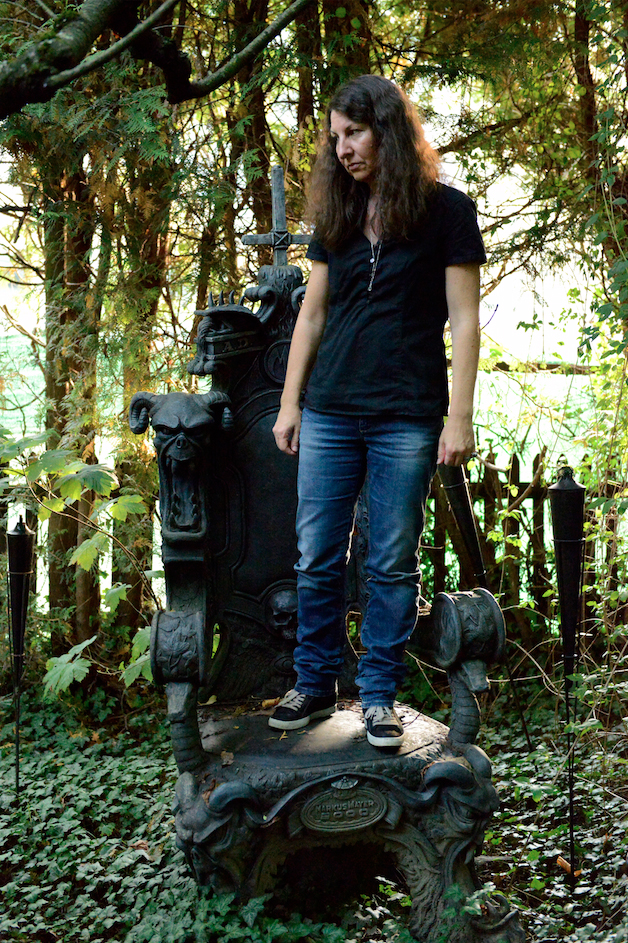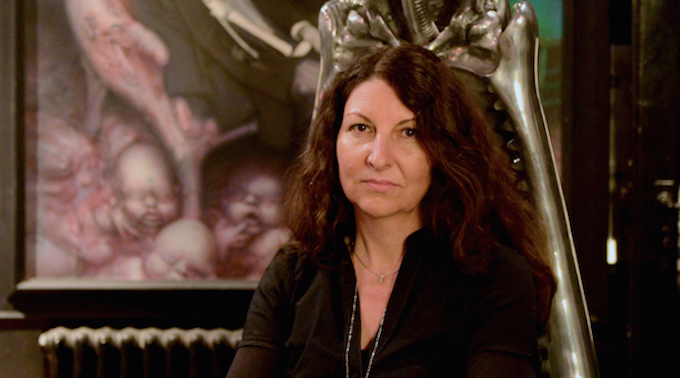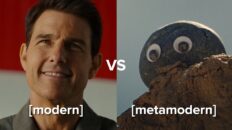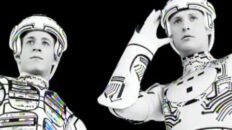Childbirth is never fully, consciously processed. The first few hours a human makes its way out of the womb into the world is a life threatening situation and is so traumatic that we never want to revisit the experience. This new documentary film reflects on how Giger accurately portrays these dark emotions and events in his art and how we can all relate to such traumatic events.
This documentary presents the last few months of Giger’s life along with interviews with the artist, his partners, assistants and past lovers to cover history and inspirations. It’s shot very well and is just as intriguing as Giger’s art. It was amazing to see Giger’s living conditions during the last year of his life. What with the train tracks and working train that go around and through Giger’s sculptures and artwork to the endless amounts of STUFF stacked everywhere inside his house.
The moments that stood out to me were the soft tender scenes where Giger was talking about his childhood and fear of death, or Giger lovingly petting his cat or talking about his wife who committed suicide, “I could not help her through my paintings.” These scenes helped humanize the mysterious artist who is known round the world for his erotic biomechanical artwork.
Below is an in-depth interview with the director of the project. Enjoy!
-Interview by Shahab Zargari
How did this film project get started?
One evening in autumn 2011, I happened to meet Sandra Beretta, who had been HR Giger’s life companion for several years. I was immediately interested. I mean: HR Giger?! The name evoked some deeply buried images in me. As a teenager I had held the album cover Brain Salad Surgery by the band Emerson Lake and Palmer in my hands. The film Alien had forever changed my perception of the science fiction genre, making it my favourite ever since. Works like Birth Machine and Li I belonged to the images of my youth. They hung as posters in record stores, or in the shared flats of my friends. But it was the first meeting with HR Giger that truly solidified my interest in making the film. Upon entering his house, I was completely overwhelmed by impressions. Crossing the threshold was like entering another world. It was like I had entered one of HR Giger’s works of art, dark and threatening. I took a seat in a Harkonnen Capo Chair and was surrounded by Giger images, Giger figures and Giger objects. The richness of detail was amazing. Despite the strange forms, the shrunken heads and skulls, I felt completely at ease. This was surely due to my host. HR Giger was friendly, polite and welcoming. At first, the artist didn’t really seem to fit with his art, and vice versa. The image I had of him as an unapproachable artist with a dark nature was wrong. HR Giger wasn’t the man I thought he was. On the contrary – and that was more interesting, more surprising. By that time, at the very latest, the film about HR Giger had begun to take shape in my head. But it was not my intention to realize a conventional biography of HR Giger. It was my intention to show the world he lived in, his extraordinary houses. He literally lived in his art with all consequences. He made the uncanny, the sinister, the scary his home and remained a very charming, humorous and friendly man. By showing all this, I hope the film sparks a new, unencumbered dialogue about HR Giger and his work.
Was Giger supportive from the get go about being filmed?
As I mentioned, HR Giger’s former life partner, Sandra Beretta, introduced me to him; she opened the door. This was a big advantage for me. Giger himself saw that my research was serious and my knowledge of his work profound. That’s something he seemed to appreciate. Fortunately I live near by Giger’s house. So I paid him many, many visits in Zurich-Oerlikon. Upon meeting him, I immediately accepted the fact that the word wasn’t his medium and that I’d have to use other ways and means to realize the film. I think HR was pleased when he realized that I understood that. We were on the same wavelength somehow, and didn’t need to speak much between us. It was also high time for a project like this. But he said, clearly, that this would be the last time he would participate in a project of this nature. I think HR understood his participation in the shooting and his appearance in this film as his last performance. At the beginning of the film, HR shows us his first skull, the one he dragged through the streets of his hometown on a string at the age of six, when most children are hugging their teddy-bears! Then, almost seventy years later, he bravely participated in the film despite of his weak health. This is itself quite a provocative decision in a society that is obsessed with youth, beauty and fitness. In my opinion, Giger was make himself conspicuous to us in the eternal cycle of birth, life and death. He became a part of his work. The film was his last performance, his last piece of art. I’m sure, he knew this since the beginning of the shooting, he knew exactly what he was doing. And I was there at the right time.
You utilize historical archive footage to help tell the entire story. Aside from home videos Giger offered, how hard was it to license the other clips?
It wasn’t difficult to license the archive material. The rights for all the material we used were held by HR Giger himself. That goes for the Making-of Alien, say, which Giger himself made with then-wife Mia. The acquisition of these rights was a precondition for his work with 20th Century Fox.
In the film Giger’s staff seemed, in 2014, very tired of working with 20th Century Fox. Could you elaborate as to why this was?
It’s true that Giger wasn’t always happy about working with 20th Century Fox. In his opinion he wasn’t sufficiently recompensed for his enormous efforts on Alien. The time pressure was great and Giger found it difficult to swiftly realise his vision with his crew. The studio bosses, too, didn’t always understand his artistic intentions – unlike Ridley Scott. The two of them were very friendly and understood each other very well. The whole story is recounted more closely in the Alien Diaries, published in 2013.
Is the Giger museum still open, and what city is it located in?
Of course it is still open. It is located in Gruyères, Switzerland. www.hrgigermuseum.com
Now that this project is finished, what are you onto now?
A lot of ideas, a few projects that I’m starting now, but nothing to share just yet.
Thank you so much for your time! Looking forward to more of your work!
DARK STAR is opening theatrically in the U.S. and Canada in over 30 cities:
May 15-21 – New York, NY – Landmark Sunshine
May 15-21 – Los Angeles, CA – Landmark NuArt
May 15-21 – San Francisco, CA – Landmark Opera Plaza
May 15-21 – Berkeley, CA – Landmark Shattuck
May 15-21 – Providence, RI – Cable Car Cinema
May 22-28 – Long Beach, CA – The Frida Cinema
May 22-28 – San Diego, CA – Landmark Ken
May 22-28 – Dallas, TX – Texas Theatre
May 23-26 – Austin, TX – Alamo Drafthouse
May 23-28 – Houston, TX – Alamo Drafthouse
May 28 – June 4 – Washington, D.C. – Landmark E St
May 28 – June 4 – Vancouver, BC – The Cinematheque
May 29 – June 4 – Denver, CO – Landmark (TBD)
May 28 – June 4 – Columbus, OH – Gateway Film Center
May 29 – June 4 – Philadelphia, PA – Landmark Ritz
May 28 – May 31 – Fort Worth, TX – Fort Worth Museum of Contemporary Art
View additional theatrical dates here:
http://icarusfilms.com/










